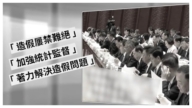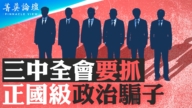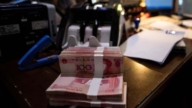【新唐人2011年8月11日讯】“创新”,可以说是世界各国都在奋力追求的好事。但中国许多评论人士则认为,什么好事只要到了中国,就难免变得邪乎起来,甚至可以邪乎得厉害。中国的创新到底在多大程度上是自主的?为什么曾经有过四大发明的古国如今却没有一个享誉世界的品牌?
“中国自主创新的高速铁路技术已经大大超过日本”;“中国高铁安全性无可置疑,绝对不会发生列车追尾事故”……中共铁道部官员,专家的这些豪言壮语言犹在耳,造成数百人伤亡的7•23温州动车追尾事故发生了。
中共耗费巨资的这次创新,却邪乎的令世界各国的铁路专家,至今仍然感到迷惑不解。自动防止列车追尾事故的技术,在日本和欧洲已经非常成熟,以至于列车司机在列车上睡着了也不会发生追尾。但在中国却发生了,而且事故还是源于中共押上政府面子的“国产”、“创新”的列控系统上。
中国现在的高速铁路多是引进日本、德国和加拿大的技术,引进日本的技术尤其多,但在台面上却不提。日本《产经新闻》称它是“盗版新干线”。
各国媒体也普遍报导,中国的高速铁路技术,很大一部分是来自中国以合作为名,盗窃的日本技术。《澳大利亚人报》日前引用日本高速铁路研究设计专家的话说,“中国只是在早先的项目上进行了合作,然后,就盗窃了他们的技术,把他们排除在外。与此同时,中方寻找机会建立中国国内的高铁庞大网络,并试图建立高铁出口产业。”
日本《朝日新闻》7月5号报导,“川崎重工的总裁大桥忠晴声称,如果中国高铁海外申请专利的内容,与中国和川崎重工关于新干线技术出口的契约相抵触,将不得不对中国提起诉讼”。
时事评论家伍凡:“中国实际上是没有创新的,因为中国现在的社会制度,人们的思想状态,尤其是政府带头,盗窃外国的资产,尤其是智慧资产。”
抱怨中国以合作为名盗窃技术的,不仅仅是日本,还有俄国。
俄罗斯的《真理报》记者谢尔盖•阿尔马索夫在2009年4月22号发表报导,题目是“中国无耻的盗窃俄罗斯喷气战斗机技术。”
时事评论家横河:“这个山寨行为仿造行为呢,是一种政府行为。一直到现在,中国的‘歼’系列基本上,除了一个型号之外,基本上都是仿造现在俄国这个系统。即使是中国现在完全自己设计的,但它的发动机还是要用俄国的,它发动机还是过不了关。”
面对外国公司和媒体质问,中国究竟有多少自己的自主创新,不由令人反思,这个曾经以四大发明傲称世界的古国,如今为什么连一个叫的响的国际品牌也没有?
时事评论家横河:“这就跟中国发展模式有关系。中共在这近三十年来,它的发展模式实际上就是要GDP,就是要把这个速度加上去,它并没有一个长远的,或者是按照经济规律的,一个全套的工业系统。这就是为什么中国到了现在,它的经济总量已经成为世界第二了,它仍然没有一个能够拿到世界上去的品牌。”
另外,横河表示,大量购买国外技术,官员可以从中捞取回扣等油水,这也是造成自主创新无法发展的原因之一。
美国“马里兰州立大学”战略和创业教授阿尼尔•古普塔,和中国印度研究所干事合伙人王海燕(译音)7月28号在《华尔街日报》发表的一篇文章指出,中国用于研究和开发的政府资金配置严重政治化;研究注重数量而不是质量,使用本国的而不是国际的标准来评价研究;学术欺骗严重;教育制度强调死记硬背,不鼓励学生创造性的解决问题,这些都是造成中国研究人员众多、资金雄厚、但技术创新却乏善可陈的部分原因。
新唐人记者梁欣、尚燕、孙宁采访报导。
Chinese Innovation under Question
“Innovation” is what the whole world is striving for.
However, many Chinese commentators said that
once a good thing is implemented in China,
it inevitably becomes incredible abnormal.
To what extent is China’s innovation independent?
Why this ancient country with Four Great Inventions
nowadays doesn’t even possess a world-renowned brand?
“China’s independently developed high-speed rail
technology has significantly surpassed Japan’s.”
“There’s no doubt with China’s high-speed rail safety;
there will never occur a rear-end crash.”
The grandiloquence of the officials and experts
of Ministry of Railways are still ringing in people’s ears.
There occurred the Wenzhou train crash on July 23.
The accident caused hundreds of casualties.
The costly innovation by the Communist Party (CCP) is so
abnormal that it puzzles railway experts around the world.
The technology that can automatically prevent crashes
is very mature in Japan and in Europe.
Even if the train driver sleeps on the train,
there would be no rear-end train crash.
But the accident did happen in China,
and the reason behind is train control system innovated
domestically by the CCP, as a “prestige project.”
Most of China’s current high-speed railways use
the technologies of Japan, Germany and Canada,
among which most are imported from Japan.
But this is never mentioned in public.
Japan’s Sankei Shimbunm calls China’s high-speed rails
“pirated versions of the Shinkansen.”
The media of various countries reported that the majority of
China’s high-speed rail technologies were stolen from Japan,
in the name of project collaboration.
The Australian quoted Japanese high-speed rail experts that
after collaborating on early projects,
China stole Japan’s technology and froze the experts out,
as it looked to establish a vast domestic network
as well as an export industry in high-speed rail.
Japan’s media Asahi Shimbun’s reported on July 5 that
Tadaharu Ohashi, president of Kawasaki Heavy Industries
said that “If the content of the overseas tenet application of
China’s high-speed railway contravenes
the Shinkansen technology export contract
signed by China and Kawasaki Heavy Industries.
They will have to sue China.
Current issue commentator Wu Fan:
China actually has no innovation,
because of China’s current social system and
the people’s state of mind,
especially that the government takes the lead to steal
foreign assets and intellectual properties in particular.
Complaints about China’s stealing of technology
under color of cooperation not only came from Japan,
but also from Russia.
Russia’s newspaper Pravda published in April 2009 article
“China Brazenly Steals Russian Jet Fighter Technology.”
Current Issue Commentator Heng He:
Such copycat is governmental behavior.
Except China’s jet fighter “Jian” series,
the rest are all imitations of the Russian system.
Even if they are by China’s own design,
their motors are still made in Russia .
Facing questions from foreign companies and media,
how many independent innovations does China have?
Why this ancient country with Four Great Inventions
now doesn’t possess even one world-renowned brand?
Heng He: This is related to China’s development model.
In the past 30 years, the CCP’s model is GDP-oriented.
It only wanted to accelerate the development speed.
However, it didn’t have an integral system designed
for long term or a system that follows economic patterns.
This is why China’s total economic output has become
the world’s No.2 but still without a world-class brand.
Heng He said that bulk purchase of foreign technologies
enables the officials to get rebates.
This contributes to the failure in development of China’s
independent innovations.
Anil Gupta, professor of Strategy & Entrepreneurship,
University of Maryland and Haiyan Wang,
managing partner of China India Institute,
wrote an article published on Wall Street Journal on July 28.
The article says in China, processes for allocating
government funds for R&D projects remain highly politicized.
Research heavily focus on quantity over quality.
They use local rather than international
standards to assess research productivity.
Academic frauds are rampant.
The educational system emphasizes on rote learning
rather than creative problem solving.
Due to these reasons, although having lots of researchers,
and abundant funds, China’s innovations are still stymied.
NTD reporters Liang Xin, Shang Yan and Sun Ning



























